Aquarium knife fish: types, content and compatibility
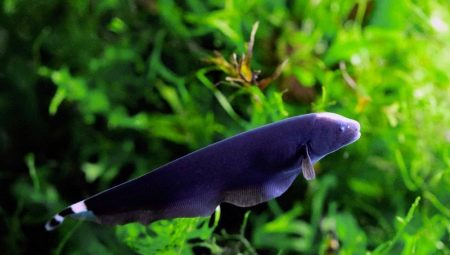
An aquarium fish that instantly arouses interest is the white-fronted aperonotus (or knife fish). She is unusually graceful, mysterious, with unusual behavior and high intelligence. "Black Ghost", as it is also called, is a real find for lovers of exotic fish species. However, it is mostly preferred by professionals., insofar as she is demanding on the conditions of detention. If you neglect them, then the pet will constantly get sick or die.
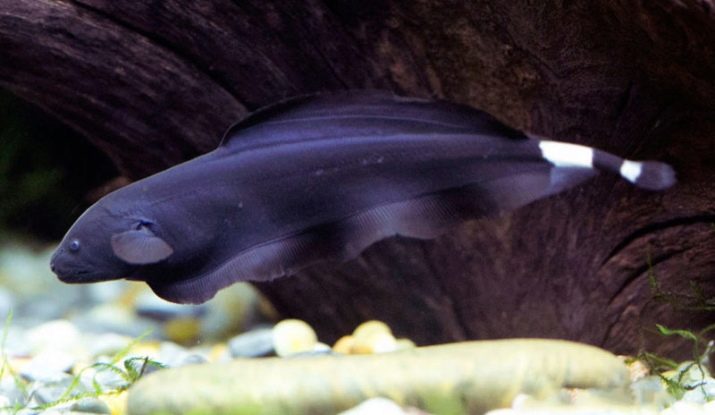
Features of the view
The fish got its name due to its shape resembling a knife blade (slightly elongated and flat). And the presence of a long black fin underneath further enhances the resemblance. This representative of the aquatic fauna does not have the usual dorsal and pelvic fins, which makes it different from other aquarium fish. Due to the large anal fin from head to tail and two small pectorals, the knifefish can swim in the water. The movements are flexible and soft.
The habitat of the white-fronted aperonotus is the Amazon ponds with a slight current and overgrown places where you can hide. One of the features of the species is the presence of poor eyesight. But the knifefish is a predator, perfectly navigating in troubled waters. Despite her vision problems, she is an excellent hunter due to the weak electromagnetic field that forms around her.
This ability makes it possible to hunt, defend, recognize objects around, communicate with other members of their species.
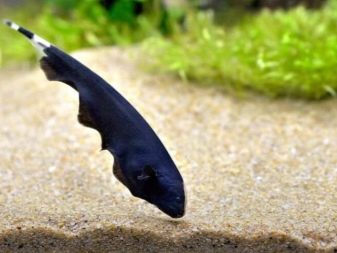

In its natural environment black knives can be up to half a meter long and live up to 15 years. The second feature of the species is the complete absence of scales. The skin is velvety, coal-black. There is a white spot on the head, turning into a thin strip and stretching along the entire ridge to the tail, ending in two vertical white rings. Such an unusual structure allows the fish to move in all sorts of ways (on the side, up, down, back, forward, belly up, hang in one place).
The Indian ocellated knife differs from its congeners by its external color (gray-silver color), the presence of small scales and a miniature dorsal fin. The lower body has a series of black spots that resemble eyes.

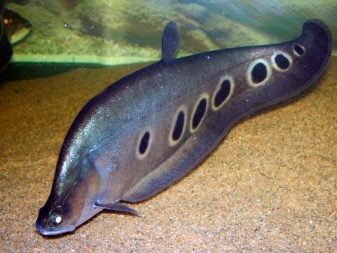
How to take care of it properly?
Mostly all aquarium fish offered by pet stores are foreigners. Knife fish is no exception, therefore it requires certain rules in the content. It is important to create conditions as close as possible to the natural habitat.
- Give preference to large, spacious aquariums (about 150-300 liters). In such a water inhabitant it will be much more comfortable and calmer. She also needs space for growth and strong immunity.
- Water temperature - 23-28 degrees Celsius, hardness - 5-19 dGH, pH - 6.0-8.0.
- The black knife spends most of its life at the bottom, hiding in a shelter. Fine gravel or sand is ideal as a substrate. For shelter, choose driftwood, purchased castles or caves, broken clay pots, transparent pipes, stone grottoes.
- Do not forget about the external filter with an ultraviolet sterilizer, which prevents the occurrence of many diseases. This fish species is sensitive to any changes in water parameters, in particular to copper, zinc and large doses of drugs.
- The black ghost leaves a lot of waste products, so the water in the aquarium needs to be changed once a week.
- Fish will appreciate the low flow aerator installed in the aquarium.
- Lighting should be soft and dim. Cloudy water is best.
- Please note that the black ghost is a nocturnal predator: it goes hunting in the dark.


What to feed?
Although the white-lime aperonotus is rather whimsical to the conditions of its keeping, the same cannot be said about nutrition - the fish is undemanding to food. She can eat both dry food and frozen food. The main thing is that the diet is varied and balanced.... This is the key to good development and good health of your pet.
The basis of the diet is protein food: bloodworms, tubifex, brine shrimp, krill, squid or shrimp meat, small fish, worms, larvae, fish fillets, various insects. With regard to dry food, the black knife eats it very rarely and reluctantly. As a hunter, he still prefers live food. The main thing is not to overfeed, otherwise there will be problems with the intestines, which can lead to the death of the ateronotus.
The knifefish should be fed once a day, either early in the morning or in the evening at sunset with the lights off. Best of all at night, that's when she is more active. Try to feed around the same time.
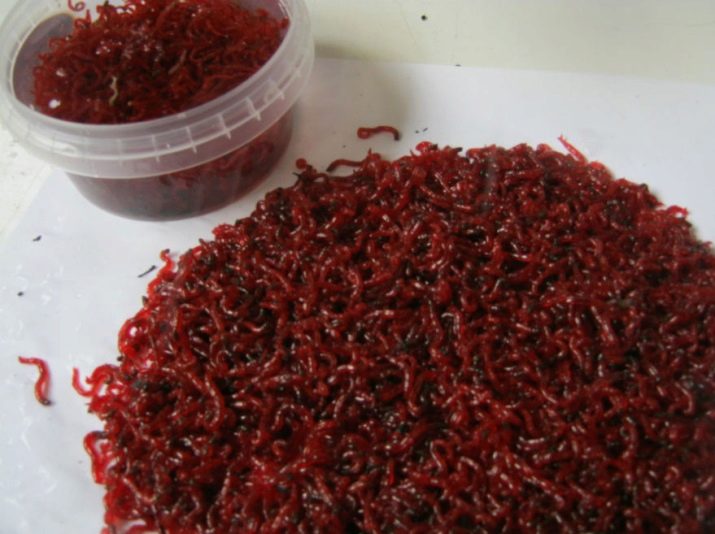
With whom to settle?
The character of the black knife is quite peaceful. He practically does not care who his neighbors are. However, its docile disposition is poorly compatible with many aquatic inhabitants. Small fish such as guppies, cardinals, neons, swordtails are perceived as food and can willingly eat. Large ones with bright colors frighten the knife fish with excessive active movements.
For example, zero compatibility with ocular astronotus. He possesses pugnacious and can eat fins. The same goes for to the barbs, who are also not averse to pinching them. In addition, black ghosts are categorically do not tolerate each other... Apteronotus gets along well with clowns, stingrays, scalars, kissing gouras, discus and other similar fish.
If you want to become the owner of two or three knives, then take care of a large aquarium and more shelters so that they do not fight for territory.
This is especially true of Indian knives, arranging real fights, which end in serious damage or death of an individual.
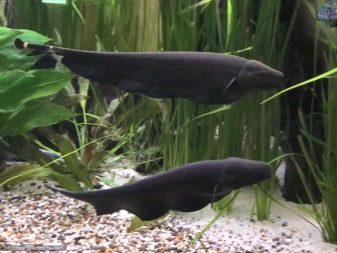
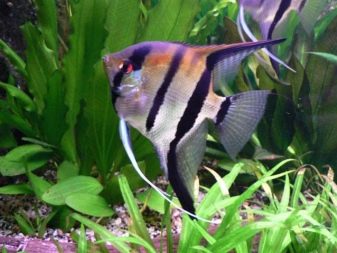
How to reproduce?
At home, breeding black knives is quite difficult. The process is extremely laborious and requires some experience. It is necessary to prepare a spawning tank with a volume of 150-200 liters. And also have 3 individuals (2 males and 1 female). As such, there are no external differences between males and females. Usually females are smaller, and males have a small fat bump on the back of their heads.
Knife fish is a tropical inhabitant and reproduces in nature during the rainy season. It is necessary to simulate natural conditions for effective spawning. It is advisable to create a lot of humidity and set the water temperature at around 28 degrees. To stimulate spawning, the water level in the aquarium is lowered, which is then added in small portions over several weeks.

Take care of the current: it should be moderate. Black knife females throw eggs under running water, laying them directly into the ground. The female can lay about 500 eggs at a time, but most of them die. As the spawning ends, the female should be deposited in a separate container and one male should be left to care for the eggs until the fry appear. After their formation, the parent is also removed, otherwise they will become food.
Within 2–4 days, the caviar of the knife fish matures. Fry care is not easy. Light should be diffused, since they absolutely do not tolerate bright light and hide in all the cracks. Water required clean, you need to change it every day by half... The first few days from the offspring, the fry feed on the yolk sac, then crushed zooplankton is introduced into the diet. Kids are gradually taught to eat adult food. The main thing is to feed often and in small portions..
If everything is done correctly, then in the first month the fry will reach 5–7 cm in length and will not differ in any way from adult knives.
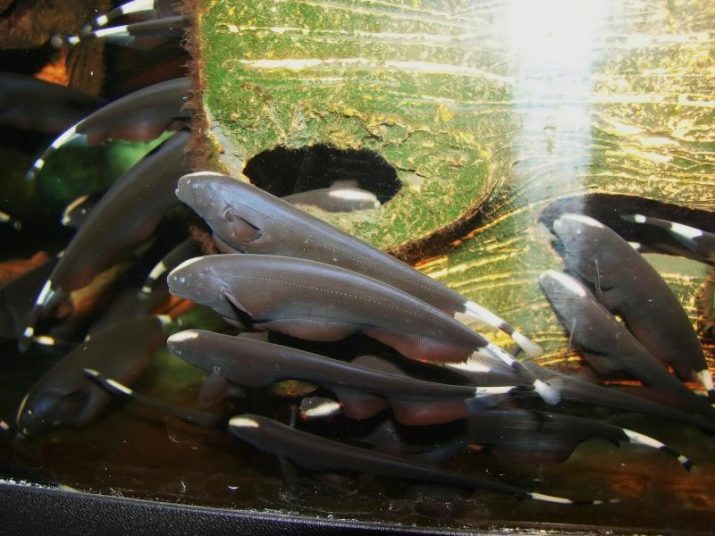
What is ill and how to treat?
With proper maintenance and care, black ghosts practically do not get sick. The only ailment that overcomes them is ichthyophthiriosis (an infectious disease caused by ciliated infusoria). This is due to the lack of scales on the body. The main sign is the appearance of white dots in the form of a decoy on the body.
For treatment, salt or special medications without zinc are used. A small concentration of saline water is added to the aquarium. After such simple manipulations, the fish very quickly recover from an illness. The main thing is to help in time.
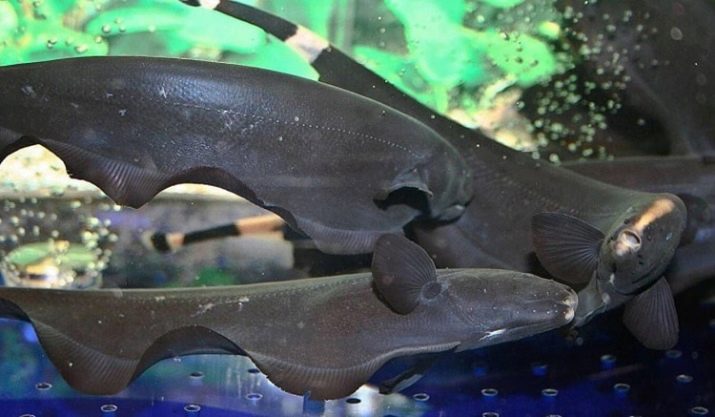
For more information about the features of this fish, see the next video.








